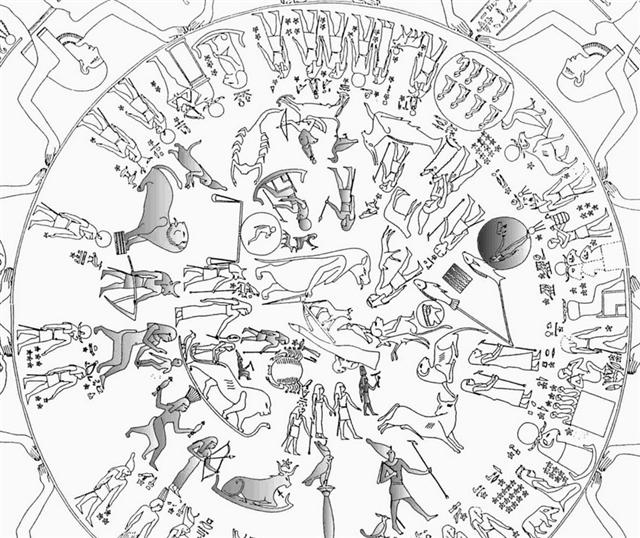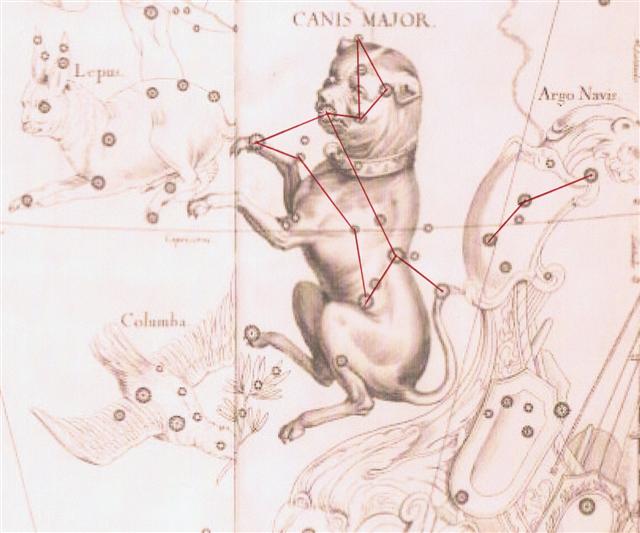224. Once again: What was Sampo? I have no straightforward answer, but clues were given in the sequence of the 4 primeval evil creations:
First we can perceive how they probably represented figures in the night sky. The Plough was where the Wolf was standing up in the Draco constellation according to the ancient Babylonians (and the Egyptians). The Cow had the Sun-disc on her head and on her forehead were the stars of Ursa, also high up close to the north pole.
The golden Bow which arose from the flames in the first day of creation could have referred to the Babylonian Bow figure. ... Arrow (Sirius & probably other adjacent stars in Canis Major) Although closely associated with the constellation of the Bow, the Arrow is always treated separately in Babylonian tradition. The annual rising of the Arrow marked the summer solstice when the sun was at its maximum height above the horizon. The Arrow was probably chosen for this role as it is the man-made object that can reach highest into the heavens. Similarly, the bird on a high perch, which is often seen besides the Arrow in ancient artwork, can also be thought of as representing the sun at its highest station ...
The Boat could haver referred to the Cargo-Boat at the beginning of the Milky Way River. ... Cargo-Boat (Pisces Australis): The mythic function of the Cargo-Boat was probably to transport the souls of new-born children from the ancestral realms towards the realms of living. The 'Cargo' refers to various objects carried in the boat that symbolize the sex of the child - boys are represented by throwing sticks and axes, girls by spindles, hair-clasps and needles. Pabilsag (Sagittarius): Pabilsag is the direct forerunner to the centaur-archer that we know today as Sagittarius. His name can be translated as the 'Chief Ancestor' or 'Forefather', and he can be best compared to the Wild Hunter of western folklore who guides the souls of the dead to the afterlife over the course of the winter months. Goatfish (Capricorn): The Goatfish rises after the winter solstice, when it announces the welcome return of the sun. I believe that the Goatfish is one of the relatively new constellation figures and can be best understood in terms of two older constellations - the Stag which announces the returning sun, and the Fish which guides the sun through the darkness of winter ... Ilmarinen apparently avoided to break the red Boat of early morning to pieces, but that is due to omission in the translation in Hamlet's Mill. From the Swedish translation of Kalevala it is clear that also the Boat was broken by the Smith. (Furthermore, the Bear-stars on the forehead of the Cow were the stars of Ursa Major, not those in Ursa Minor). ... The hull of the canoe was regarded as the backbone of their chief. In laments for dead chiefs, the deceased are often compared to broken canoes awash in the surf ... The 4 ancient creations were pieces which could be reused in forging the Sampo. Which probably means the pictures on the cover of Sampo included such ancient pictures. But there were colours on the cover and such, I have stated, should mean the Sun was present. However, this will not necessarily exclude nighttime, because there were stars which had colours and the Sun was a kind of star: ... 'The sun's rays,' he went on, 'are fire and the Nummo's excrement. It is the rays which give the sun its strength. It is the Nummo who gives life to this star, for the sun is in some sort a star.' Moreover, the glorious Sirius (brilliant white and yellow) was evidently a nighttime reflection of the daytime Sun: ... The Sothic cycle was based on what is referred to in technical jargon as 'the periodic return of the heliacal rising of Sirius', which is the first appearance of this star after a seasonal absence, rising at dawn just ahead of the sun in the eastern portion of the sky. In the case of Sirius the interval between one such rising and the next amounts to exactly 365.25 days - a mathematically harmonious figure, uncomplicated by further decimal points, which is just twelve minutes longer than the duration of the solar year ... ... the seasonal cycle, throughout the ancient world, was the foremost sign of rebirth following death, and in Egypt the chronometer of this cycle was the annual flooding of the Nile. Numerous festival edifices were constructed, incensed, and consecrated; a throne hall wherein the king should sit while approached in obeisance by the gods and their priesthoods (who in a crueler time would have been the registrars of his death); a large court for the presentation of mimes, processions, and other such visual events; and finally a palace-chapel into which the god-king would retire for his changes of costume ... ... Pliny wants to assure us that 'the whole sea is conscious of the rise of that star, as is most clearly seen in the Dardanelles, for sea-weed and fishes float on the surface, and everything is turned up from the bottom'. He also remarks that at the rising of the Dog-Star the wine in the cellars begins to stir up and that the still waters move ... ... On Easter Island one of the names for Sirius was Te Pou (pillar, pole, etc), perhaps because it was not affected by the precession - this star pillar stood unmoved in the flow of time ... Possibly the precession had moved the ancient boat Argo Navis away from midsummer so that Sirius had taken over this cardinal point. And modern astronomers have broken Argo Navis to pieces (Puppis, Carina, Vela, etc.).
|



